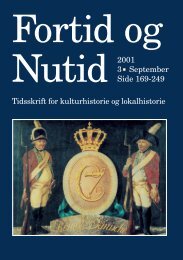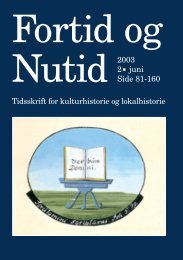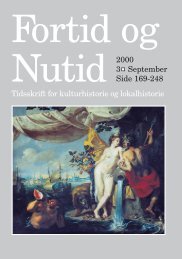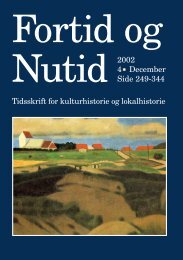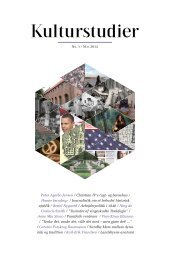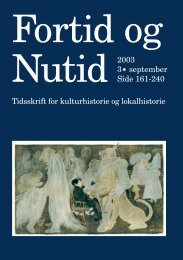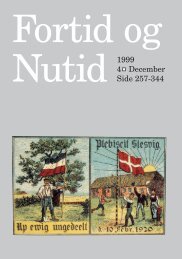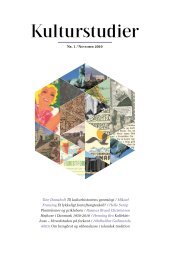Læs hele tidsskriftet (PDF) - Kulturstudier
Læs hele tidsskriftet (PDF) - Kulturstudier
Læs hele tidsskriftet (PDF) - Kulturstudier
Create successful ePaper yourself
Turn your PDF publications into a flip-book with our unique Google optimized e-Paper software.
<strong>Kulturstudier</strong> Nr. 2, 2011 The reconfigured body 12/15<br />
are doomed to be reconfigured. However, the patients that have gone through<br />
xenotransplantations strive to overcome the boundlessness that they experience.<br />
This was noticed by the ethnologist Susanne Lundin while interviewing patients<br />
with diabetes, who in the beginning of the 1990s received transplants of pancreatic<br />
islets from pigs, she describes how these patients strived to find manageable<br />
definitions after being transplanted:<br />
“It is clear that my informants are searching for manageable definitions of<br />
what is foreign and what is their own. They share a will to find principles for<br />
how to handle matter from a foreign species. In this context, the body is a central<br />
point. For when biotechnology makes it possible to transgress and even<br />
erase fixed boundaries, between different bodies and life forms, a need arises<br />
to place oneself in a meaning-creating system. As we have seen, this applies<br />
to donations and transplants in general, but it is seen with particular clarity<br />
in the case of xenotransplants.” 39<br />
However for biotechnological development, the reconfiguring of the human and<br />
animal bodies, and thus also the changing relationship between these two bodies,<br />
was central to the creative processes of discovering new treatments. Such a<br />
perspective opens up different aspects. The boundlessness between bodies and<br />
objects is the desirable approach, a place where the pig’s body can be objectified<br />
in new ways and the researchers and the biotechnology companies can create<br />
biomedicine that can be commoditized. For the medical researchers it is central<br />
to challenge the traditional dualism between human and animal. The meaningcreating<br />
system for the medical researchers is, in contrast to the patient, the<br />
boundless body.<br />
The reconfiguration of objects is an important part of how biotechnological<br />
research constantly creates new objects. It is something other than the patients<br />
searching for manageable definitions of what is foreign; instead it is the foreign<br />
that is of interest. 40 As the sociologist Bryan S. Turner points out: “Technology<br />
appropriates nature by alienation: that is by reconstituting it as an object. But in<br />
the alienation of nature, ‘Man’ opens up the possibility of working on the body, of<br />
transforming human ontology”. 41 It is vital to point out the variance in patient’s<br />
views of how to handle this boundlessness. It is also important to discuss which<br />
networks make it possible for biotechnological research to strive for a reconfiguring<br />
of the body.<br />
39 Lundin 1999, p. 20-21.<br />
40 Lundin 1999.<br />
41 Turner 2007, p. 23.<br />
153



